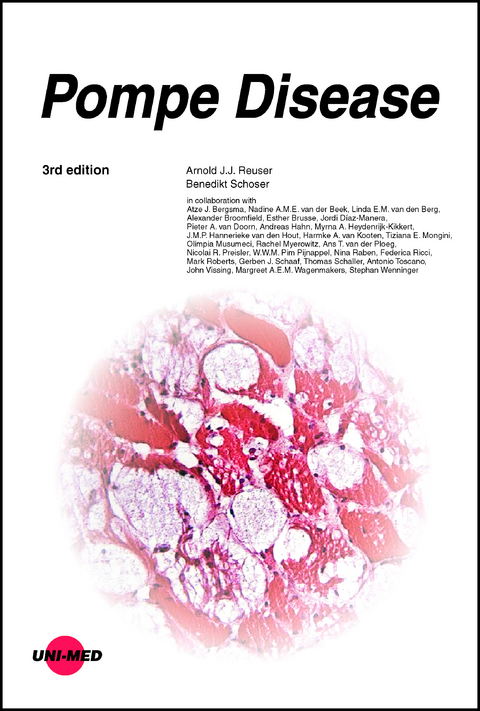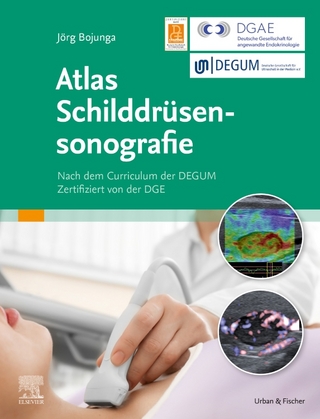Pompe Disease
UNI-MED (Verlag)
978-3-8374-2433-1 (ISBN)
- Titel nicht im Sortiment
- Artikel merken
This edition highlights the significant advances in the understanding of disease mechanisms, in describing the phenotypic spectrum of Pompe disease, in developing diagnostic algorithms and in improving patient care. We summarized the current techniques contributing to disease diagnosis, predictive genetic testing and therapy development.
This third edition of 'Pompe Disease' was updated particularly with regards to the clinical spectrum, the diagnostic procedures, the efficacy of enzyme replacement therapy, and future gene therapy. It provides helpful information to healthcare professionals as well as to interested lay people on all aspects of Pompe disease.
1.Introduction17
1.1.History and Terminology17
1.2.Pompe Disease as Lysosomal Glycogen Storage Disorder19
1.3.Epidemiology20
2.From Genetic Defect to Clinical Symptoms23
2.1.In General23
2.2.From the GAA Gene to Functional Lysosomal GAA24
2.2.1.GAA pre-mRNA Splicing24
2.2.2.Translation, Post-Translational Processing and Intracellular Transport25
2.3.From GAA Deficiency to Cellular Pathology27
2.3.1.GAA Deficiency and Ensuing Cellular Damage27
2.3.2.Rescue of Damaged Muscle Tissue by Satellite Cells29
2.4.The Genotype-Phenotype Correlation29
2.5.The Pompe Variant Database and the Pompe Registry32
2.6.Summary33
3.Autophagy and its Role in the Pathogenesis of Pompe Disease38
3.1.Autophagy: Background38
3.2.Autophagy in Pompe Disease: Focus on Skeletal Muscle40
3.3.Conclusion43
4.Clinical Spectrum46
4.1.Classic Infantile Pompe Disease46
4.1.1.Clinical Presentation, Diagnosis, and Natural Course of Disease46
4.1.2.The New Phenotype50
4.2.Childhood Pompe Disease53
4.3.Adult Pompe Disease55
4.3.1.Clinical Findings55
5.Diagnosis65
5.1.Clinical Chemistry65
5.2.Muscle Imaging Procedures66
5.2.1.Infants and Children with Pompe Disease66
5.2.2.Adult Pompe Disease67
5.3.Examination of the Cerebral Vessels69
5.4.Examination of Cardiac Function70
5.5.Examination of Pulmonary Function71
5.6.Electromyographic Examination71
5.7.Muscle Biopsy71
5.8.Measurement of Enzyme Activity74
5.9.DNA Analysis75
6.Prenatal Diagnosis, Population Screening and Counselling82
6.1.Introduction82
6.2.Prenatal Diagnosis82
6.3.Preimplantation Genetic Testing (PGT)83
6.4.Newborn and Population Screening84
7.Differential Diagnosis of Pompe Disease88
7.1.Differential Diagnosis of Classic Infantile Pompe Disease88
7.2.Differential Diagnosis of Childhood Pompe Disease90
7.3.Differential Diagnosis of Pompe Disease in Adults92
7.3.1.HyperCKemia92
7.3.2.Fatigue and Myalgia92
7.3.3.Proximal and Axial Muscle Weakness93
7.3.4.Rigid Spine Syndrome94
7.3.5.Respiratory Impairment94
8.Respiratory Impairment in Pompe Disease97
8.1.Weakness of the Respiratory Muscle System in Pompe Disease97
8.1.1.Respiratory Impairment in Classic Infantile Pompe Disease97
8.1.2.Respiratory Impairment in Adult Pompe Disease97
8.1.3.Consequences of Respiratory Muscle Weakness98
8.1.4.The Course of Respiratory Muscle Weakness99
8.2.Respiratory Function Testing99
8.2.1.Pulmonary Function Tests (PFTs)99
8.2.2.Respiratory Muscle Function and Manometry99
8.2.3.Polysomnography100
8.3.Management of Respiratory Insufficiency101
8.3.1.Respiratory Muscle Training (RMT)101
8.3.2.Mechanical Ventilation101
8.3.3.Cough Augmentation Techniques102
8.3.4.Respiratory Function under Enzyme Replacement Therapy102
9.Enzyme Replacement Therapy in Pompe Disease105
9.1.The History and Development of ERT with a Focus on Pompe Disease105
9.2.Basic Principles of ERT108
9.3.Enzyme Replacement Therapy in Infants111
9.3.1.The First Trials111
9.3.2.ERT for Infants and Children in Clinical Practice: Achievements and Unmet Medical Needs114
9.3.3.Dosing116
9.3.4.CRIM Status117
9.3.5.Antibody Formation117
9.4.Immunomodulation under Enzyme Replacement Therapy118
9.5.Enzyme Replacement Therapy in Children122
9.6.Enzyme Replacement Therapy in Adults124
9.6.1.Alglucosidase Alfa Studies in Adults: Late Onset Treatment Study (LOTS)124
9.6.2.Alglucosidase Alfa Studies in Adults: Real World Data125
9.6.3.Alglucosidase Alfa Studies in Adults: 10-year Data and Unmet Needs126
9.6.4.Second Generation ERT126
9.7.Gene Therapy128
10.Exercise Training and Rehabilitation Management in Pompe Disease141
10.1.Exercise Training141
10.1.1.Exercise141
10.1.2.Effect of Endurance and Resistance Exercise in Pompe Disease142
10.1.3.Exercise in Treatment Naive Patients142
10.1.4.Adverse Effects of Exercise142
10.2.Rehabilitation Management of Adults143
10.2.1.Presymptomatic Patients143
10.2.2.Ambulant and Less Affected Patients144
10.2.3.Severely Affected and Wheelchair-Bound Patients144
10.2.4.The New Phenotypes144
10.3.Rehabilitation Management of Patients with Classic Infantile Pompe Disease145
11.Dietary Aspects of Pompe Disease149
11.1.Body Mass Index and Body Composition149
11.2.Protein Degradation and Energy Expenditure150
11.3.Optimal Composition of Diet in Pompe Disease151
11.4.Separate Supplementation of Different Amino Acids151
11.5.Dietary Suggestions for Pompe Patients in Clinical Practice152
12.Patient Support Groups155
13.Abbreviations158
Index159
| Erscheinungsdatum | 18.02.2022 |
|---|---|
| Reihe/Serie | UNI-MED Science |
| Verlagsort | Bremen |
| Sprache | englisch |
| Maße | 175 x 245 mm |
| Gewicht | 450 g |
| Einbandart | gebunden |
| Themenwelt | Medizinische Fachgebiete ► Innere Medizin ► Endokrinologie |
| Schlagworte | lysosomal storage disorder • Morbus Pompe • Pompe Disease |
| ISBN-10 | 3-8374-2433-2 / 3837424332 |
| ISBN-13 | 978-3-8374-2433-1 / 9783837424331 |
| Zustand | Neuware |
| Haben Sie eine Frage zum Produkt? |
aus dem Bereich




